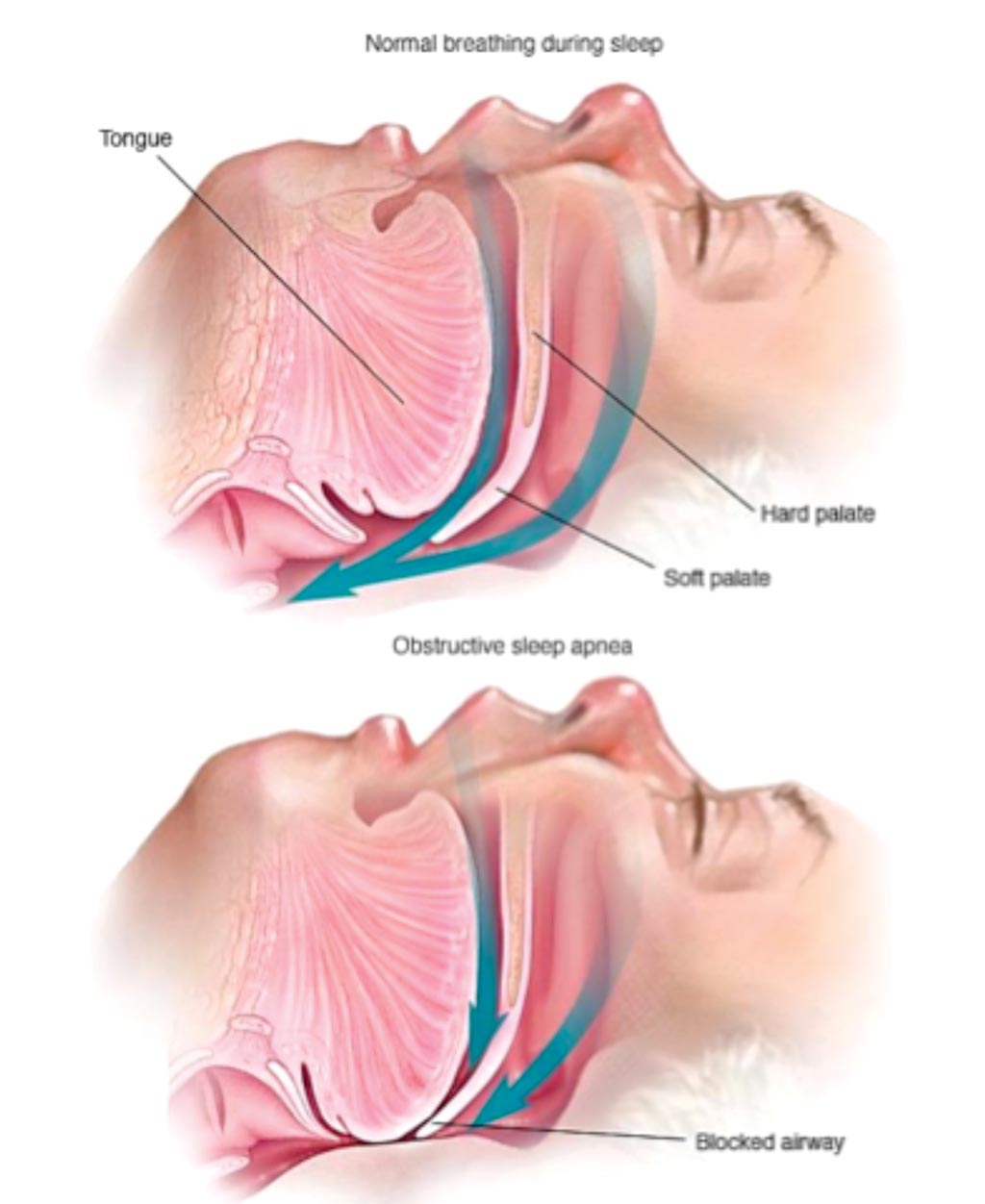Sleep Disorder Linked with Abnormal Lipid Levels
|
By LabMedica International staff writers Posted on 05 Sep 2018 |

Image: An illustration of obstructive sleep apnea compared to normal breathing during sleep (Photo courtesy of Mayo Clinic).
Obstructive sleep apnea is a disorder in which breathing is repetitively interrupted during sleep due to collapse of the upper airway. An apnea is defined as complete cessation of breathing lasting 10 seconds or greater.
Dyslipidemia is an abnormal amount of lipids such as triglycerides, cholesterol and/or fat phospholipids in the blood. Both obstructive sleep apnea (OSA) and dyslipidemia are independent risk factors for cardiovascular disease.
An international team of investigators led by scientists at the Sahlgrenska Academy (Gothenburg, Sweden) carried out a cross‐sectional analysis that included 8,592 patients without physician‐diagnosed hyperlipidemia or reported intake of a lipid‐lowering drug (age 50.1 ± 12.7 years, 69.1% male, BMI: 30.8 ± 6.6 kg/m2, mean apnea–hypopnea index (AHI): 25.7 ± 25.9 events/hour). The independent relationship between measures of OSA (AHI, oxygen desaturation index (ODI), mean and lowest oxygen saturation) and lipid profile (total cholesterol (TC), high‐density was calculated.
The team reported that there was a dose response relationship between TC and ODI (mean ± SE (mg/dL): 180.33 ± 2.46, 184.59 ± 2.42, 185.44 ± 2.42 and 185.73 ± 2.44; across ODI quartiles I–IV). Triglycerides (TG) and low-density lipoprotein cholesterol (LDL-C) concentrations were better predicted by AHI than by ODI. High-density lipoprotein-cholesterol (HDL‐C) was significantly reduced in the highest AHI quartile (mean ± SE (mg/dL): 48.8 ± 1.49 versus 46.50 ± 1.48; AHI quartile I versus IV). Morbid obesity was associated with lower TC and higher HDL‐C values. Lipid status was influenced by geographical location with the highest TC concentration recorded in Northern Europe.
The authors concluded that OSA severity was independently associated with cholesterol and TG concentrations. HDL‐C, LDL‐C, and fasting TG was determined by means of general linear model analysis. Dr. Ludger Grote, MD, PhD, a professor and senior author of the study, said, “Our data clearly suggest that sleep apnea may have a negative impact on lipid levels, which may in part explain the association between sleep apnea and increased risk for cardiovascular disease. Patients with sleep apnea therefore need careful management of all cardiovascular risk factors including hyperlipidemia.” The study was published on August 21, 2018, in the journal Respirology.
Related Links:
Sahlgrenska Academy
Dyslipidemia is an abnormal amount of lipids such as triglycerides, cholesterol and/or fat phospholipids in the blood. Both obstructive sleep apnea (OSA) and dyslipidemia are independent risk factors for cardiovascular disease.
An international team of investigators led by scientists at the Sahlgrenska Academy (Gothenburg, Sweden) carried out a cross‐sectional analysis that included 8,592 patients without physician‐diagnosed hyperlipidemia or reported intake of a lipid‐lowering drug (age 50.1 ± 12.7 years, 69.1% male, BMI: 30.8 ± 6.6 kg/m2, mean apnea–hypopnea index (AHI): 25.7 ± 25.9 events/hour). The independent relationship between measures of OSA (AHI, oxygen desaturation index (ODI), mean and lowest oxygen saturation) and lipid profile (total cholesterol (TC), high‐density was calculated.
The team reported that there was a dose response relationship between TC and ODI (mean ± SE (mg/dL): 180.33 ± 2.46, 184.59 ± 2.42, 185.44 ± 2.42 and 185.73 ± 2.44; across ODI quartiles I–IV). Triglycerides (TG) and low-density lipoprotein cholesterol (LDL-C) concentrations were better predicted by AHI than by ODI. High-density lipoprotein-cholesterol (HDL‐C) was significantly reduced in the highest AHI quartile (mean ± SE (mg/dL): 48.8 ± 1.49 versus 46.50 ± 1.48; AHI quartile I versus IV). Morbid obesity was associated with lower TC and higher HDL‐C values. Lipid status was influenced by geographical location with the highest TC concentration recorded in Northern Europe.
The authors concluded that OSA severity was independently associated with cholesterol and TG concentrations. HDL‐C, LDL‐C, and fasting TG was determined by means of general linear model analysis. Dr. Ludger Grote, MD, PhD, a professor and senior author of the study, said, “Our data clearly suggest that sleep apnea may have a negative impact on lipid levels, which may in part explain the association between sleep apnea and increased risk for cardiovascular disease. Patients with sleep apnea therefore need careful management of all cardiovascular risk factors including hyperlipidemia.” The study was published on August 21, 2018, in the journal Respirology.
Related Links:
Sahlgrenska Academy
Latest Clinical Chem. News
- New Method Uses Pulsed Infrared Light to Find Cancer's 'Fingerprints' In Blood Plasma
- Carbon Nanotubes Help Build Highly Accurate Sensors for Continuous Health Monitoring
- Paper-Based Device Boosts HIV Test Accuracy from Dried Blood Samples
- AI-Powered Raman Spectroscopy Method Enables Rapid Drug Detection in Blood
- Novel LC-MS/MS Assay Detects Low Creatinine in Sweat and Saliva
- Biosensing Technology Breakthrough Paves Way for New Methods of Early Disease Detection
- New Saliva Test Rapidly Identifies Paracetamol Overdose
- POC Saliva Testing Device Predicts Heart Failure in 15 Minutes

- Screening Tool Detects Multiple Health Conditions from Single Blood Drop
- Integrated Chemistry and Immunoassay Analyzer with Extensive Assay Menu Offers Flexibility, Scalability and Data Commutability
- Rapid Drug Test to Improve Treatment for Patients Presenting to Hospital
- AI Model Detects Cancer at Lightning Speed through Sugar Analyses
- First-Ever Blood-Powered Chip Offers Real-Time Health Monitoring
- New ADLM Guidance Provides Expert Recommendations on Clinical Testing For Respiratory Viral Infections
- 3D Printed Point-Of-Care Mass Spectrometer Outperforms State-Of-The-Art Models
- POC Biomedical Test Spins Water Droplet Using Sound Waves for Cancer Detection
Channels
Molecular Diagnostics
view channel
Rapid Blood Test Identifies Pre-Symptomatic Patients with Parkinson’s Disease
Currently, no reliable blood test exists for diagnosing Parkinson’s disease. Instead, physicians rely on observing a patient's movements, but this qualitative method has an error rate of 20%-25% and can... Read more
Blood Test for Early Alzheimer's Detection Achieves Over 90% Accuracy
Alzheimer's disease (AD) is a debilitating condition and a leading cause of disability and death worldwide. The availability of reliable diagnostic tools is currently restricted, and diagnosis often relies... Read more
RNA-Based Blood Test Detects Preeclampsia Risk Months Before Symptoms
Preeclampsia remains a major cause of maternal morbidity and mortality, as well as preterm births. Despite current guidelines that aim to identify pregnant women at increased risk of preeclampsia using... Read more
First Of Its Kind Test Uses microRNAs to Predict Toxicity from Cancer Therapy
Many men with early-stage prostate cancer receive stereotactic body radiotherapy (SBRT), a highly precise form of radiation treatment that is completed in just five sessions. Compared to traditional radiation,... Read moreHematology
view channel
New Scoring System Predicts Risk of Developing Cancer from Common Blood Disorder
Clonal cytopenia of undetermined significance (CCUS) is a blood disorder commonly found in older adults, characterized by mutations in blood cells and a low blood count, but without any obvious cause or... Read more
Non-Invasive Prenatal Test for Fetal RhD Status Demonstrates 100% Accuracy
In the United States, approximately 15% of pregnant individuals are RhD-negative. However, in about 40% of these cases, the fetus is also RhD-negative, making the administration of RhoGAM unnecessary.... Read moreImmunology
view channel
Stem Cell Test Predicts Treatment Outcome for Patients with Platinum-Resistant Ovarian Cancer
Epithelial ovarian cancer frequently responds to chemotherapy initially, but eventually, the tumor develops resistance to the therapy, leading to regrowth. This resistance is partially due to the activation... Read more
Machine Learning-Enabled Blood Test Predicts Immunotherapy Response in Lymphoma Patients
Chimeric antigen receptor (CAR) T-cell therapy has emerged as one of the most promising recent developments in the treatment of blood cancers. However, over half of non-Hodgkin lymphoma (NHL) patients... Read moreMicrobiology
view channel
Handheld Device Delivers Low-Cost TB Results in Less Than One Hour
Tuberculosis (TB) remains the deadliest infectious disease globally, affecting an estimated 10 million people annually. In 2021, about 4.2 million TB cases went undiagnosed or unreported, mainly due to... Read more
New AI-Based Method Improves Diagnosis of Drug-Resistant Infections
Drug-resistant infections, particularly those caused by deadly bacteria like tuberculosis and staphylococcus, are rapidly emerging as a global health emergency. These infections are more difficult to treat,... Read more
Breakthrough Diagnostic Technology Identifies Bacterial Infections with Almost 100% Accuracy within Three Hours
Rapid and precise identification of pathogenic microbes in patient samples is essential for the effective treatment of acute infectious diseases, such as sepsis. The fluorescence in situ hybridization... Read morePathology
view channel
"Metal Detector" Algorithm Hunts Down Vulnerable Tumors
Scientists have developed an algorithm capable of functioning as a "metal detector" to identify vulnerable tumors, marking a significant advancement in personalized cancer treatment. This breakthrough... Read more
Novel Technique Uses ‘Sugar’ Signatures to Identify and Classify Pancreatic Cancer Cell Subtypes
Pancreatic cancer is often asymptomatic in its early stages, making it difficult to detect until it has progressed. Consequently, only 15% of pancreatic cancers are diagnosed early enough to allow for... Read moreTechnology
view channel
Pain-On-A-Chip Microfluidic Device Determines Types of Chronic Pain from Blood Samples
Chronic pain is a widespread condition that remains difficult to manage, and existing clinical methods for its treatment rely largely on self-reporting, which can be subjective and especially problematic... Read more
Innovative, Label-Free Ratiometric Fluorosensor Enables More Sensitive Viral RNA Detection
Viruses present a major global health risk, as demonstrated by recent pandemics, making early detection and identification essential for preventing new outbreaks. While traditional detection methods are... Read moreIndustry
view channel
Cepheid and Oxford Nanopore Technologies Partner on Advancing Automated Sequencing-Based Solutions
Cepheid (Sunnyvale, CA, USA), a leading molecular diagnostics company, and Oxford Nanopore Technologies (Oxford, UK), the company behind a new generation of sequencing-based molecular analysis technologies,... Read more
Grifols and Tecan’s IBL Collaborate on Advanced Biomarker Panels
Grifols (Barcelona, Spain), one of the world’s leading producers of plasma-derived medicines and innovative diagnostic solutions, is expanding its offer in clinical diagnostics through a strategic partnership... Read more







.jpg)













